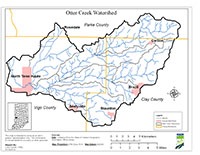Location
The Otter Creek Watershed is located in west-central Indiana, draining approximately 124 square miles in Clay, Parke, and Vigo Counties. Major streams included in the TMDL report are Otter Creek, Sulphur Creek, Gundy Ditch, and North Branch Otter Creek as well as tributaries.
History
A comprehensive survey of the Otter Creek watershed was conducted by Indiana Department of Environmental Management (IDEM) in 2009. The primary cause of impairment is Escherichia coli bacteria (E. coli) sources in the watershed include non-point sources e.g. row crop agriculture and pastures, urban and rural runoff, land application of manure, and point sources e.g. straight pipe dischargers, and failing home sewage treatment system disposal.
Pollutants Addressed
TMDLs for the Otter Creek watershed are established for Escherichia coli bacteria (E. coli) and addressed 23 impairments. Some of the recommended solutions to address the impairments include storm water controls, point source controls, manure management, and habitat improvements.
Timeline
A public kickoff meeting was held to introduce the project and solicit input on January 17, 2011 at the Vigo County Annex, 127 Oak Street, Terre Haute, IN, 47807.
A draft TMDL public meeting was held on June 4, 2013 in Terre Haute, IN at the Vigo County Annex.
The 30-day public comment period followed the draft TMDL public meeting from June 4, 2013 to July 4, 2013.
U.S. EPA under Section 303(d) of the Clean Water Act has yet to approve the Otter Creek Watershed Total Maximum Daily Load (TMDL) report. TMDL reports identify and evaluate water quality problems in impaired water bodies and propose solutions to bring those waters into attainment with water quality standards.
Subsequent to its approval, inaccuracies in the final report were discovered by IDEM, who informed U.S. EPA in December 2017. IDEM explained that it had mischaracterized how bacteria TMDLs in the final Otter Creek Watershed TMDL report were calculated. A memorandum from IDEM and revised decision document from U.S. EPA were issued as a result.

